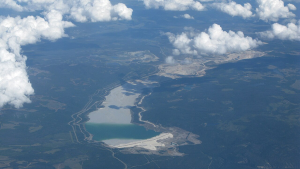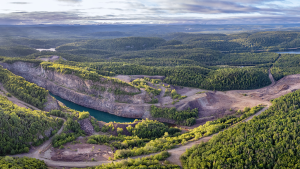GENIVAR, a publicly-traded engineering company with 40 offices across Canada, has been chosen to lead the design of four wind farms being proposed for B.C.’s Tumbler Ridge/Chetwynd area in northern B.C. by Finavera Renewables Inc., which specializes in wind and wave energy technology.
GENIVAR, a publicly-traded engineering company with 40 offices across Canada, has been chosen to lead the design of four wind farms being proposed for B.C.’s Tumbler Ridge/Chetwynd area in northern B.C. by Finavera Renewables Inc., which specializes in wind and wave energy technology.
B.C. vice-president for GENIVAR Daryl Thomas, who is leading the engineering project team, said the province has yet to generate any wind power although several projects are under construction. B.C. is coming to the table relatively late in the game as other provinces such as Quebec (Gaspe Peninsula is the site of one of the world’s largest wind farms) and Alberta (Cowley Ridge) have taken the Canadian lead in harvesting wind. “We in B.C. are a net importer of power,” says Thomas, even though there is a misperception of having an infinite hydro resource for power generation. As a result, BC Hydro is eager to develop new sources, including independent projects and alternative, environmentally friendly sources of power generation.
The new sources must also fit with power needs. Thomas says that often-traditional hydro generation of power is hampered by low flows in winter and summer, periods when the snow pack is accumulating or has run off. “New projects must be able to generate power during the winter when water is not flowing,” he says, adding that wind farms are an ideal fit as the inclement weather peaks during this period.
BC Hydro has been carrying on its own feasibility studies on the viability of wind farms for approximately five years. Two prime sites have been identified: the area atop of Vancouver Island along with the Mainland’s northern coastal and the Peace River/Tumbler Ridge area.
Currently GENIVAR is collecting data on wind frequency and strength at sites to determine which will be the best areas for the four designated projects. “All the risk is in the wind assessment,” says Thomas, who says he is fortunate to have the expertise of the firm’s Quebec office which was involved in assessing sites through the installation of roads and turbines for many of the larger projects.
The four Finavera wind farms will have a combined output of 366 MW with GENIVAR doing the design and preparations of engineering drawings, construction management, and specifications for turbine installation and commissioning.
Finavera project developer Maura Macdonald said ideally the company wants all four farms in the area to proceed, however, much would hinge on the engineer’s report and also whether the company is able to get a contract to supply power to the BC Hydro grid. The timeline plans call for applying to BC Hydro this fall or early 2008 when a tender call is put out to independent power producers. “We expect that we may achieve environment assessment certificate (EAC) approval by late 2008,” she says. Construction, expected to begin in 2010, would be subject to approval from BC Hydro. The cost of the 366 MW project is being estimated. “The rough rule of thumb that would apply to wind energy is $1.5 – $2 million per megawatt of wind energy to install it,” says Macdonald, adding “That is based on the best wind and closest to transmission line.”
Expected to be one of the first to begin generating power is Mount Hays Wind Farm, located on 731 hectares at the top of Mount Hays, four km south of Prince Rupert, where 17 turbines are being sited. In September 2006, Katabatic Power Corp., in Richmond, B.C., (which owns the project) signed a 25-year power purchase agreement with BC Hydro. Golder Associate Ltd. has been hired to carry out environmental impact and construction studies in the area. Construction was started in 2007 and an in service date of November 2007 is being given by the company.
Katabatic also announced in January 2007 that it had entered into an agreement with Deutsche Bank AG to develop the world’s largest wind farm capable of generating 3,000 MW on B.C.’s northern coast. The $6 billion project, developed through a joint-venture subsidiary known, as North Coast Wind Energy Corporation will be located on Banks Island. The company is currently seeking an energy purchasing agreement with BC Hydro and anticipating construction to start in 2009.
In August, Bear Mountain Wind Ltd. Partnership was given environmental approval for the construction of a $240 million wind farm 16 km southwest of Dawson Creek in northern B.C. The 120-megawatt project originally called for 60 turbines, but an environmental review rolled back the number to 57. The project also includes a transmission line to the BC Hydro grid, substation, and access roads. Commercial power production is slated to begin in 2009. The Bear Mountain Partnership includes Victoria-based Aeolis Wind Power Corp., Dawson Creek-based Peace Energy Co-operative and Alberta-based AltaGas Income Trust. Bear Mountain signed a 25-year energy agreement with BC Hydro last year.
The Dokie Wind Energy project is currently under construction on Dokie Ridge in the Rocky Mountain foothills of the Peace River region after winning a 20-year power purchase agreement with BC Hydro in 2006. The project was the largest in 2006 with an estimated output of 180 megawatts. It has also obtained an EAC, completed its engineering design, as well as First Nations and community review. Pre-construction work started in late 2006. Dokie Wind Energy Inc., established in 2004, a joint-venture between Victoria-based Earth First Energy Inc. and Calgary-based Creststreet Capital Corporation. It owns all leases, test wind towers and other related development assets for Dokie Ridge, one of the top-ranked wind resources in B.C.
Seabreeze Power was one of the first companies in B.C. to gain EAC approval five years ago, however, the project has now progressed to the stage where it is looking to respond to the next BC Hydro call for tenders, says marketing and communications manager Monique Stevenson. The project cost is estimated at $250 million.
The firm’s Northern Vancouver Island Knobb Hill Wind Farm gained approval for more than 450 MWs, but will begin with the construction of a 99 MW wind farm. The farm is to be located at a site 35 km from Port Hardy. Power generated would be transmitted to BC Hydro’s substation at Port Hardy. However, the project’s ability to go forward will hinge upon receiving a power purchase agreement from BC Hydro.










Recent Comments
comments for this post are closed